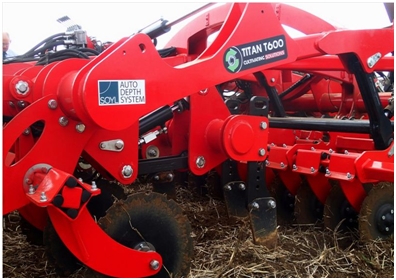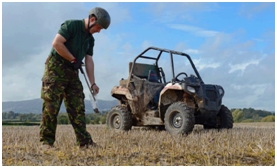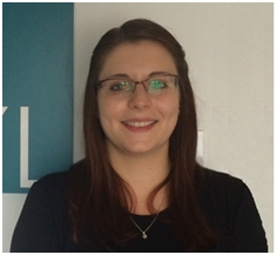SOYL Newsletter August 2015
1. See benefits of variable depth cultivation at Tillage Live Growers attending this year's Tillage Live event will have the opportunity to see demonstrations of SOYL's variable depth cultivation system, Autodepth. With the opportunity to improve soil structure and potential to deliver cost savings, variable depth cultivation is being met with increasing levels of interest from arable growers.
Growers attending this year's Tillage Live event will have the opportunity to see demonstrations of SOYL's variable depth cultivation system, Autodepth. With the opportunity to improve soil structure and potential to deliver cost savings, variable depth cultivation is being met with increasing levels of interest from arable growers.SOYL will demonstrate how soil structure is affected by standard cultivations, using fresh soil pits to show the impact of tines at different levels. This will allow growers to see where tines have passed through the soil at depths that may be appropriate, but also where they have gone too shallow and too deep.
David Whattoff, SOYL's development manager, explains the importance of cultivating at different depths, 'soil needs to be friable to cultivate successfully. Clay soils dry out more slowly than sandy soils, so cultivating at a universal depth often leads to compromise in fields with variable soil types. In the worst cases a cultivator can damage the soil by smearing wet clay and creating compacted layers which impede plant root growth, uptake of nutrients and moisture and ultimately reduce yield.'
Cultivation plans are based on the same electrical conductivity map used for variable rate seeding. This approach ensures that depth changes are made as each soil type changes, optimising fuel consumption and benefitting soil structure at the same time. Additional features such as tramlines can also be included on the cultivation plans, ensuring that they are effectively removed during cultivation. The Autodepth control unit can be retrofitted to existing farm machines as well as being added to new purchases.
To learn more about Autodepth and variable depth cultivations, visit SOYL at this year's Tillage Live event on Wednesday 16th September at Croft Farms, near Darlington. As part of the Tillage Knowledge Trail, growers can also gain NRoSO and BASIS points by visiting SOYL at stand 106 and working plot 11. Alternatively, you can speak to your local SOYL contact to find out more about Autodepth.
2. A day in the life of a sampler
 Now harvest is well underway, soil sampling can begin. Analysing samples to identify variations in phosphorus, potassium, magnesium and pH levels can help growers to reduce waste and improve yields. This is a very busy period for our nationwide team of over 40 SOYL samplers, including Stuart Fensom, who gives us an insight into his role.
Now harvest is well underway, soil sampling can begin. Analysing samples to identify variations in phosphorus, potassium, magnesium and pH levels can help growers to reduce waste and improve yields. This is a very busy period for our nationwide team of over 40 SOYL samplers, including Stuart Fensom, who gives us an insight into his role.I'm usually on farm before 8am to start sampling the first field, so that I can make the most of the daylight hours and work as efficiently possible. First of all, I meet with the grower to discuss my planned work for the day and any problem areas in-field. I then drive a GPS boundary of the field which is stored and used for all future nutrient maps and recommendations.
My next task is to create a grid of sample points and take 16 cores at each location to create one sample to a specified depth. This is labelled and stored ready for delivery to the lab for analysis. We have the flexibility to take additional samples too if there are any areas of the field that need special attention. I'll organise collection of the samples for that evening and my GPS files automatically synchronise with SOYL's database ready for the office team to process.
The data from the samples will be used to create a map showing nutrient variation across each field which will justify future fertiliser use. SOYL's service also includes advice to help the grower understand the map and how it can be used to benefit the business.
So many factors can affect the nutrient status of different parts of the field, including previous cropping, previous applications of fertiliser and manures and changes to field boundaries. Our detailed sampling can pick up differences that the grower never realised were there and provides an accurate starting point that enables growers to reduce application rates and consequently, fertiliser bills, as well as boosting yields where nutrients or acidity have been limiting factors in the past.
During the peak season I'm usually out in the field seven days a week. I love the time I spend outside and relish the fact that I'm working independently. I also get to see some amazing places and enjoy the variety of wildlife around me, whether that is a deer grazing in the field or making friends with the resident Shetland pony; they're all things that make this role so enjoyable. There is also a massive sense of achievement after a hard day's work. You can visibly see how much land you've covered and know that the work you've done will help the farmer improve the profitability of their crop.'
Clear land after harvest is ideal for conducting soil sampling. SOYL's network of trained samplers can obtain this data which can then be used to make informed management decisions and target fertiliser inputs variably to match crop needs. To book sampling for this autumn, please contact your SOYL area manager or call Rebecca Kearsey on 01635 204190.
3. 2016 cropping reminder
For fertiliser recommendations for this growing year, please send a cropping report to This email address is being protected from spambots. You need JavaScript enabled to view it. or call 01635 204190 to request a prepopulated electronic or paper copy. You can also submit a plan direct from Farmade Gatekeeper or Muddy Boots Crop Report.
4. Meet Kelly Gurney
 "I started working for SOYL in 2012. As a team leader, I make sure that we deal with customer requests and recommendations quickly and to high standards. This is particularly relevant at the moment as it's the peak period for lime recommendations and a fast turnaround is key to make sure the window for spreading isn't missed. I find this one of the most challenging periods of the year as there are often lots of people involved in the request stage and sometimes investigative work is needed to get the full picture.
"I started working for SOYL in 2012. As a team leader, I make sure that we deal with customer requests and recommendations quickly and to high standards. This is particularly relevant at the moment as it's the peak period for lime recommendations and a fast turnaround is key to make sure the window for spreading isn't missed. I find this one of the most challenging periods of the year as there are often lots of people involved in the request stage and sometimes investigative work is needed to get the full picture.As autumn approaches, the P and K application season will take centre stage. On a typical day at this time of year, I'll process the cropping information for a number of accounts to create their variable rate fertiliser recommendations, as well as creating the application files throughout the day. I'm FACTs qualified, so also spend time talking to customers about their recommendation and giving them advice if they're not sure what approach to take. When doing this I need to look at the bigger picture in terms of the practicality of applications as well as the requirements of the soil and I really enjoy this aspect of my role.
Once the customer is happy with the recommendations, the final stage of the process is the production of spreading files. The office team has experience in dealing with a wide range of GPS kits from multiple manufacturers, including our own control boxes, iSOYL and SOYL-OPTI.
I'm also part of the MySOYL support team, so help growers to get set up to use the tool, give them training and answer their queries too. MySOYL and iSOYL together provide a really powerful application and recording tool; it's great being able to see the benefits of advances in technology.
No two days are the same and I'm always learning. My favourite part of the job is interaction with our customers; working together to help make a positive difference in the way they farm is very rewarding."
Don't forget you can follow us on Twitter @SOYLprecision for regular updates on soils, nutrients, machinery and GPS.










